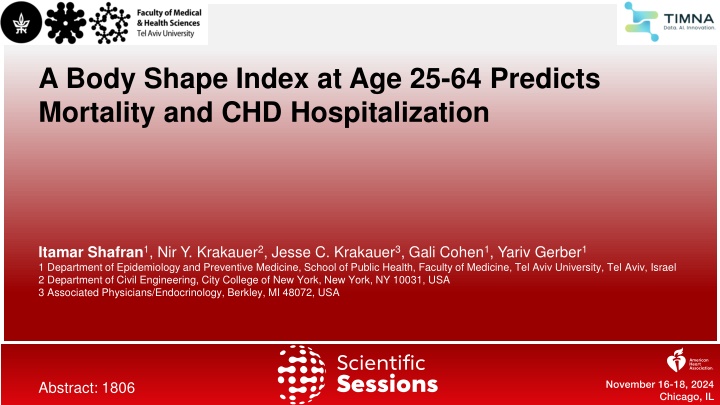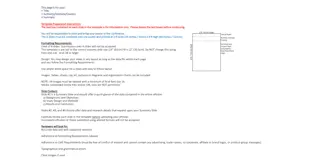
Body Shape Index at Age 25-64 Predicts Mortality and CHD Hospitalization Study
This study examines the predictive value of A Body Shape Index (ABSI) in determining cardiovascular disease (CVD) morbidity, mortality, and coronary heart disease (CHD) hospitalization in adults aged 25-64. The research, conducted using data from the First Israeli National Health and Nutrition Survey, suggests that ABSI, in conjunction with BMI, plays a significant role in forecasting these health outcomes.
Download Presentation

Please find below an Image/Link to download the presentation.
The content on the website is provided AS IS for your information and personal use only. It may not be sold, licensed, or shared on other websites without obtaining consent from the author. If you encounter any issues during the download, it is possible that the publisher has removed the file from their server.
You are allowed to download the files provided on this website for personal or commercial use, subject to the condition that they are used lawfully. All files are the property of their respective owners.
The content on the website is provided AS IS for your information and personal use only. It may not be sold, licensed, or shared on other websites without obtaining consent from the author.
E N D
Presentation Transcript
A Body Shape Index at Age 25-64 Predicts Mortality and CHD Hospitalization Itamar Shafran1, Nir Y. Krakauer2, Jesse C. Krakauer3, Gali Cohen1, Yariv Gerber1 1 Department of Epidemiology and Preventive Medicine, School of Public Health, Faculty of Medicine, Tel Aviv University, Tel Aviv, Israel 2 Department of Civil Engineering, City College of New York, New York, NY 10031, USA 3 Associated Physicians/Endocrinology, Berkley, MI 48072, USA Abstract: 1806
FINANCIAL DISCLOSURE DISCLOSURES FROM PAST 12 MONTHS: Presenter: Itamar Shafran, MD Nothing to disclose Co-author: Nir Y. Krakuer, Phd Nothing to disclose Co-author: Jesse C. Krakuer, MD Nothing to disclose Co-author: Gali Cohen, PhD Nothing to disclose Co-author: Yariv Gerber, PhD Nothing to disclose This research was supported in part by the Chief Scientist Office of the Ministry of Health, Israel, and the Israel Science Foundation. Abstract: 1806
BACKGROUND Obesity is a known risk factor for Aims: To study the predictive value of ABSI cardiovascular disease (CVD) morbidity and in conjunction with BMI for all-cause mortality mortality. and coronary heart disease (CHD) hospitalization among adult participants A body shape index (ABSI) is a waist circumference (WC) measure of abdominal obesity independent of body mass index (BMI). ?? ???? = ? ? ?????? ? ? ??? ABSI has been shown to predict mortality and numerous clinical outcomes.
METHODSAND MATERIALS Participants (n=2,225) were drawn from the First Israeli National Health and Nutrition Survey (1999-2001), constituting adults aged 25-64, representative of the Israeli population. Baseline anthropometrics, including weight, height, and WC, were measured and expressed as their allometric indices: BMI and ABSI. Mortality and hospitalization data was retrieved from TIMNA, a Big Data platform created by the Israel Ministry of Health. Cause of hospitalization was determined according to the primary and secondary reasons, documented in ICD-9 codes. Follow-up lasted through 2021 for mortality and 2022 for hospitalizations. Cox regressions assessed the adjusted risk of all-cause mortality and CHD hospitalization, adjusted for socio-demographic and clinical factors.
RESULTS Table 1. Baseline characteristics across BMI and ABSI levels The baseline mean [SD] age was 43 [11] years, and 50% were women. The correlation between BMI and WC was 0.78, and 0.02 for BMI and ABSI. Figure 1. Correlation matrix between anthropometric measures
RESULTS MORTALITY Over a median follow-up of 21 years, 247 (11.1%) deaths occurred. The multivariable-adjusted hazard ratios (HRs) for mortality per 1 SD increase were: BMI: 1.11 (95% CI: 0.97; 1.27) ABSI: 1.55 (95% CI: 1.33; 1.79) Log HR plotted against SD units and adjusted for age & sex Referenceline set to mean SD value Table 2. Hazard ratios for all-cause mortality per 1 SD increase in BMI and ABSI + Classic Risk Factors Age and Sex + Anthropometrics 1.14 (1.01-1.30) 1.09 (0.95-1.25) 1.11 (0.97-1.27) BMI 1.61 (1.39-1.86) 1.54 (1.33-1.78) 1.55 (1.33-1.79) ABSI HRs are reported per 1 SD increase (4.666 for BMI; 0.005 for ABSI). Classic risk factors: hypertension, hyperlipidemia, diabetes, and smoking status. ABSI a body shape index; BMI body mass index. ABSI exhibited a significant association with mortality risk across all standard BMI categories Adjusted for demographics and classic CVD risk factors, the HRs (95% CIs) per 1 SD increase in ABSI were 1.38 (1.01; 1.88) for individuals with a BMI of 18.5-24.9, 1.70 (1.34; 2.16) for BMI 25.0-29.9, and 1.46 (1.13; 1.87) for BMI 30.0.
RESULTS CHD HOSPITALIZATIONS Log HR plotted against SD units and adjusted for age & sex Reference line set to mean SD value Among CVD-free participants at baseline (n=2,146), 267 (12.4%) were hospitalized for CHD during follow-up. Hospitalized participants had higher ABSI (0.082 vs. 0.078, P<.001) and BMI (28.3 vs. 26.7, P<.001) than individuals who remained free of CHD hospitalizations. An increase in the adjusted HR was seen for both ABSI [1.34 (95% CI: 1.15; 1.55)] and BMI [1.16 (95% CI: 1.01; 1.33)]. Table 3. Hazard ratios for CHD hospitalization per 1 SD increase in BMI and ABSI Age and Sex + Classic Risk Factors + Anthropometrics 1.15 (1.01-1.32) 1.22 (1.07-1.38) 1.16 (1.01-1.33) BMI 1.33 (1.15-1.55) 1.35 (1.17-1.56) 1.34 (1.15-1.55) ABSI HRs are reported per 1 SD increase (4.666 for BMI; 0.005 for ABSI). Classic risk factors: hypertension, hyperlipidemia, diabetes, and smoking status. ABSI a body shape index; BMI body mass index; CHD coronary heart disease.
CONCLUSIONS In a 20-year prospective study of a middle-aged cohort, baseline ABSI was a stronger predictor of mortality and CHD hospitalizations than BMI. ABSI was independent of BMI as a predictor for mortality and hospitalizations. Further research is warranted to better understand the predictive value of ABSI, and to compare it to other obesity measurements.




